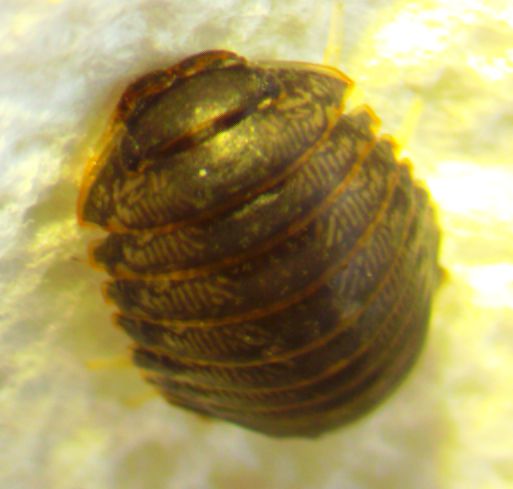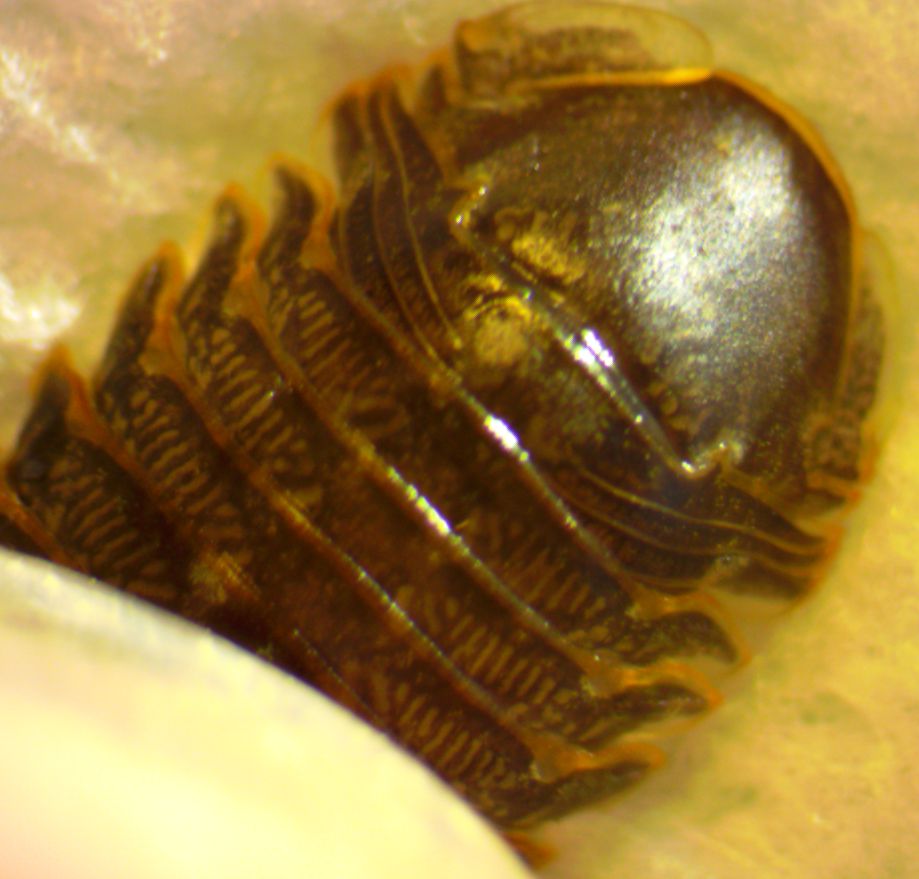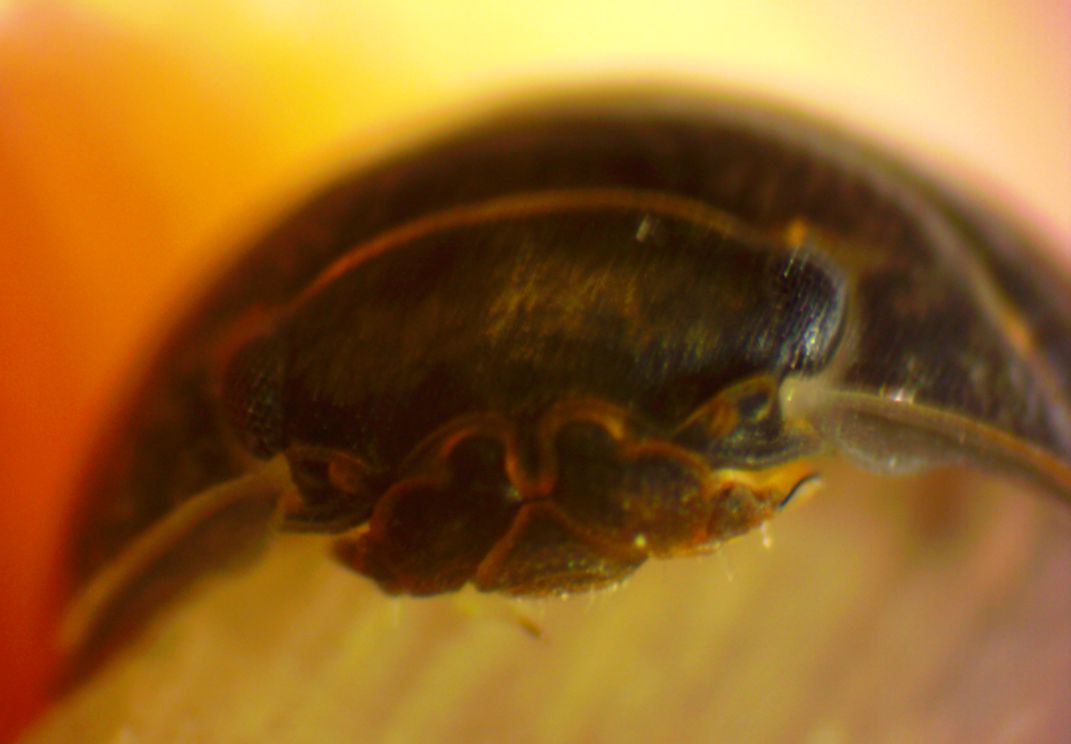Gnorimosphaeroma oregonensis Dana, 1854-55Common name(s): Oregon pill bug, Pill bug |
|
| Synonyms: Exosphaeroma oregonensis, Exosphaeroma oregonense, Gnorimosphaeroma oregonense, Neosphaeroma oregonense, Sphaeroma oregonense |  |
|
Phylum Arthropoda
Subphylum Crustacea
Class Malacostraca
Subclass
Eumalacostraca
Superorder
Peracarida
Family
Sphaeromatidae
|
|
| Gnorimosphaeroma oregonensis, about 6 mm long, found on rocks at Sares Head | |
| (Photo by: Dave Cowles, August 2017) | |
Description: Flabelliferan isopods have uropods beside the pleotelson (photo). Their body is not more than 5 times as long as wide. Their first pereopod is usually not enlarged nor subchelate. Gnoriosphaeroma oregonensis has a small rostrum which clearly separate the bases of its first antennae (photo). It has only 3 visible pleonite plates anterior to the pleotelson (the first pleonite is hidden out of sight under the last pereonite). These 3 pleonites reach as far laterally as do the segments anterior and posterior to them. The pleopods do not have respiratory folds. The animal is very flexible and active, and can roll up into a ball, which is unusual for marine isopods but common for the terrestrial pillbug. None of the pereopods is subchelate. Gray dorsally, lighter gray ventrally. Length 1 cm or less.
How to Distinguish from Similar Species: In Gnorimosphaeroma noblei the bases of the first antennae are not separated by a rostrum, so they touch in the front of the head. Gnorimosphaeroma insulare has only two of its three free pleonites reach the lateral edge of the animal-the other is shorter.
Geographical Range: Alaska to southern California
Depth Range: Intertidal to 24 m
Habitat: Under rocks on rocky or shelly coastlines, or on floats or pilings.
Biology/Natural
History: This species
lives on the open coast and in bays. Large aggregations can sometimes
be
found in areas with lowered salinity. These isopods are
unusual for
crustaceans because they have protogynous
development: When sexually mature they are first females, then change
into
males later in life (Brook et al., 1994). Other individuals develop
directly
from juveniles into males.
| Return to: | |||
| Main Page | Alphabetic Index | Systematic Index | Glossary |
References:
Dichotomous Keys:Carlton, 2007
Kozloff, 1987, 1996 (as Gnorimosphaeroma oregonense)
General References:
Kozloff,
1993 (as Gnorimosphaeroma oregonense)
Lamb
and Hanby, 2005
Morris
et al., 1980
Scientific Articles:
Brook, Heather J., Timothy A. Rawlings, and Ronald W. Davies, 1994.
Protogynous sex change in the intertidal isopod Gnorimosphaeroma
oregonense (Crustacea: Isopoda). Biological Bulletin 187:
pp 99-111
Rees, C. P., 1975. Competitive interactions and substratum preferences of two intertidal isopods. Marine Biology (Berl.) 30: pp21-25
Riegel, J. A., 1959a. Some aspects of osmoregulation in two species of sphaeromid isopod Crustacea. Biological Bulletin 116: pp272-284
Riegel, J.A., 1959b. A revision in the sphaeromid genus Gnoriomosphaeroma Menzies (Crustacea: Isopoda) on the basis of morphological, physical, and ecological studies on two of its "subspecies". Biological Bulletin 117: pp151-162
Standing, J. D., and D. D. Beatty, 1977. Humidity behaviour and reception in the sphaeromatid isopod Gnorimosphaeroma oregonensis (Dana). Canadian Journal of Zoology 56: pp2004-2014
Web sites:
General Notes and Observations: Locations, abundances, unusual behaviors:

This view of the posterior end shows the three free pleonites
which reach to the margin of the animal, the pleotelson,
and the uropods,
which are beside the pleotelson.
Photo by Dave Cowles, August 2017

This anterior view of the head shows the short rostrum
which separates the flattened bases of the basal articles
of the two first antennae. The animal must be held because otherwise it
is highly active and impossible to photograph. Photo by Dave Cowles,
August
2017

The animal can curl up into a loose ball, though it doesn't appear
to me that it curls up as tightly nor as readily as the terrestrial
pill
bugs do.
Authors and Editors
of Page:
Dave Cowles (2017): Created original page
CSS coding for page developed by Jonathan Cowles
Salish Sea Invertebrates web site provided courtesy of Walla
Walla University